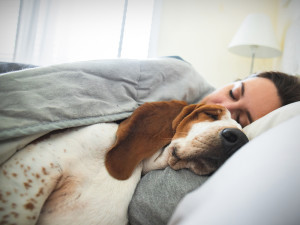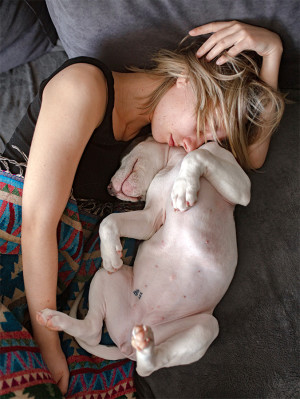Why Is My Dog Obsessed Taking Over the Whole Bed?
For some pet parents, dog-spreading is a nightly phenomenon. But if your dog defies the laws of space and gravity at night, you do have options.
As dog parents, we spend a lot of time talking about training — ways to gently convince our precious pooches to come when we call, not to pee inside the house, and to sit quietly while waiting for a treat (or five). But what about the ways that they train us? For instance: I used to be a person who sprawled out all over the bed while asleep. But now that I share it with two small dogs? Let’s just say that fully extending my legs is a privilege I rarely enjoy.
I call this phenomenon “dog-spreading.” For whatever reason, some dogs don’t just like to sleep in the bed — they defy the laws of physics by expanding to twice or thrice their normal size, stretching their limbs and turning into dead weight that refuses to be moved. After midnight, I swear my 25-pound dog turns into a boulder, plastering herself against my thigh and cornering me in what feels like two square inches of mattress space until dawn mercifully breaks. How does she do it? Why does she do it? These are questions that do not concern her, because she’s already asleep. But still, as I lay awake at night wondering what this might do to my joints after a few years, I can’t help but wonder…
Save on the litter with color-changing tech that helps you better care for your cat.
The short answer, of course, is that dogs are a lot like people and all have their individual sleeping preferences. “Some like to curl up into a cozy little ball, while others prefer to sprawl out like a starfish,” says Dr. Brian Hare, Professor of Psychology and Neuroscience at Duke University and author of Puppy Kindergartenopens in a new tab. “Some want to lean into your warmth, while others are champion kickers—it really depends on the dog’s personality.”
In other words, as Dr. Betsy Challen (DVM), Certified Dog and Cat Behaviorist and owner of Pawsitive Animal Careopens in a new tab put it, “Once you invite a dog into your bed, you never know what you are going to get.” That said, you don’t have to lie helpless in the dark. If your dog’s sleepytime antics are driving you barking mad, you have some options.
Why do dogs take over the whole bed?
The longer answer is that we kind of brought this on ourselves. Historically, both Challen and Hare point out, dogs were not often found in human beds. Before the 1980s and ’90s, Hare says, “sharing a bed with your dog often meant waking up with fleas or ticks.” But in the twenty-plus years Challen has worked as a veterinarian, she’s watched dogs move into the house after decades of sleeping Snoopy-style in backyard dog houses. Now, she says, many have their own beds and playtime set-ups.
“So, to many dog owners, dogs are like children,” Challen says, “and in this way, [pet parents] naturally have the inclination to have their dogs, often starting at the age of a puppy, sleep in their beds.” Obviously, Hare notes, the rise of preventatives has made nighttime cuddling a lot more appealing as well.
As natural pack animals, Challen says, dogs are used to sleeping together in dens, so sharing our beds is usually a no-brainer. At the same time, as many of us have noticed while waking up to our best buds’ rumps in our faces, “they don’t always make the best bed-mates.”
Why is my dog burrowing under the blankets?
While some hounds like to hermetically seal us into a small spot by pinning us under the covers, others prefer to snuggle up beneath the sheets. According to Hare, burrowing is usually completely normal — “unless it’s paired with signs of anxiety or distress.”
More often than not, dogs who like burying themselves in cotton are natural burrowers to begin with, Challen says.
One such breed, according to dog trainer Anthony Soroskyopens in a new tab, is the Daschund. “They are almost always preferring to be under the covers, often all the way down to your feet,” he says. “These dogs are wired genetically to pursue their prey down into the ground. Hence the shape of their body. They are quite good at it, too. Imagine if your job was to chase a badger down a hole and pull it out by its toes. You would have to be pretty comfortable in tight spaces. You may actually feel more comfortable in tighter spaces and prefer them.”
Is it okay to try to move my dog while they’re asleep?
My dogs might not appreciate this answer, but yes, if your dog’s chosen sleep spot is standing between you and some precious ZZZ’s, it’s totally fine to wake them up or gently coax them into another spot.
“Just gently nudge them over — unless they’re elderly, in pain, or have a history of aggression,” Hare says. “Otherwise, they’ll probably just reposition and fall right back asleep.”
It’s natural to feel hesitant, especially given that old saying about “letting sleeping dogs lie.” But for those who find themselves reluctant, Challen offers a little pep talk.
“When it comes to dogs and pets in general I often think, whose house and bed is this anyway?” Challen says. “The dog usually has its own bed and has chosen to sleep in ‘your’ bed or has been invited into your bed by you. If your dog is waking you up throughout the night and making you sleep in an uncomfortable manner then I think it is completely fine to remove your dog from your bed. After all, your dog doesn’t have a job to go to in the morning, a test to take… you get the idea. Let the dog know when he is welcomed in your bed, but also when he is not.”
And if your dog chooses not to play nice and refuses to leave the bed? “It may be time to take a good look at the relationship you have with your dog,” Challen says. Sorosky agrees: “Look around, and you will probably find a few other places where the dog is getting his [or] her way at your expense.”
What should I do if my dog growls when I try to move them?
As tempting as it might be, don’t ignore the behavior. Instead, Challen says, “I would immediately assess the situation and get the dog off the bed.”
A little growl might seem innocuous, but Challen has seen many situations in which pet parents did not intervene and then saw the behavior escalate — especially when new people like friends, new romantic partners, or children enter the bed.
“I have had to counsel many owners on what to do in this situation, and proactivity is the key,” Challen says. “If our dog is growling when touched or moved and is left to continue in this manner, it can lead to aggression.”
If you’re concerned about your dog’s growling, Sorosky suggests using a leash at night. If your dog growls, gently tug on the leash to coax them off the bed without reaching for their collar. “Sometimes, if your dog starts to realize that it is his own behavior that can get him an invitation onto the bed or get him sent off, he’s likely to make a change,” Sorosky says.
Is it wrong to banish my dog from the bed after letting them sleep in it?
Nope! As Hare points out, “Dogs are incredibly adaptable — it may take a bit of time and consistency, but they can absolutely learn a new routine.”
In some cases, your dog might already have their own safe place, like a bed or a crate. These spots can come in handy when guests or children are around, Challen says, in case your dog needs a place to settle down. If your dog already feels comfortable in their own bed, you should feel no qualms about sending them there at night.
“You will find after a while that your dog may prefer to sleep here not only overnight but during the day, when there are firestorms or when he is feeling like he wants to be left alone,” Challen says. “One of my clients missed his special cuddle time with his dog before bed, but no longer wanted his dog sleeping on the bed with him. He was willing to go cuddle his dog on his dog’s bed in his safe space prior to going to bed for the night. This was a win-win situation after both parties got used to it.”
If you’re starting from scratch, Challen says basic commands like “up” and “off” can teach your dog which places are suitable for sleep and which are not. Hare also suggests making your dog’s new nighttime digs “as positive and rewarding as possible.” Make sure the spot feels safe and cozy, and try feeding your dog meals and treats there to create happy associations. “Also,” Hare says, “a nice long walk before bedtime helps — if they’re tired out, they’ll settle in more easily.”
At the end of the day, Sorosky says, “dogs are more flexible than we may think.” So if you’re losing sleep to a roaming pooch, trust in your bond and find an arrangement that works for both of you.











